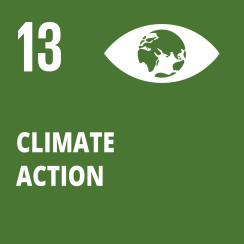
Take urgent action to combat climate change and its impacts
To reach this goal, some key targets have been outlined. They include strengthening resilience and adaptive capacity; implementing national policies, strategies and planning; improving education, awareness-raising and human and institutional capacity; addressing the needs of developing countries in the context of meaningful mitigation actions; and, raising capacity for effective climate change-related planning and management. Learn more about this goal in the Targets & Indicators section below.

Source: SciVal.com | This word cloud was created using publications from Penn State researchers
Related News
Social Science Research Institute launches climate, society, health initiative
A new Penn State initiative will focus on climate change and how extreme weather events impact human health, especially in underserved populations across the globe. The Social Science Research Institute’s (SSRI) Climate, Society and Health Initiative aims [...]
Urgent need for climate solutions spurs Penn State to launch Climate Consortium
Penn State has established a consortium focused on meeting the mounting challenges related to climate change. The Climate Consortium is a collective of internal and external partners who are committed to identifying, creating and implementing research-based solutions [...]
Climate-driven extreme heat may make parts of Earth too hot for humans
If global temperatures increase by 1 degree Celsius (C) or more than current levels, each year billions of people will be exposed to heat and humidity so extreme they will be unable to naturally cool [...]
A new glass for the future: Taking LionGlass out of the lab and into the market
One of the few things scientists know for certain about glass is that its atomic structure is chaos. Neither liquid nor solid, glass is its own phase — a material somewhere between these two states [...]
Climate-driven extreme heat may make parts of Earth too hot for humans
If global temperatures increase by 1 degree Celsius (C) or more than current levels, each year billions of people will be exposed to heat and humidity so extreme they will be unable to naturally cool [...]
Curbing cow belches in the name of climate change mitigation
A Penn State livestock emissions expert has received a grant from the Greener Cattle Initiative to develop actionable options to mitigate enteric, or intestinal, methane emissions from cattle — which are produced via belching. Alex [...]
Yes, the university tracks all its energy across all campuses and is conveniently summarized on the PSU Sustainability website under the “Campus by the Numbers” Data report.
Yes, Penn State holds multiple events surrounding this topic, including programs for local community members and students. One of the highlight events that Penn State sustainability hosts is the global climate action conference, which allows students, faculty, and community members to come together to learn about pressing climate change risks and how to implement daily behavior changes to address the issue. The Local Climate Action Program also provides mitigation for local communities. Penn State additionally offers a sustainability certificate program for professionals already in the workforce.
Penn State does not have its own Climate Action Plan. Members of the University Park campus (main campus) were integral to developing the Centre Region Council of Governments Climate Action plan. Brandi Robinson, PSU Energy Sustainability and Policy advisor, and Peter Buckland, PSU Sustainability Academic Programs Manager, were instrumental in this process.
Yes, Penn State currently collaborates with smallholder farmers across Africa, Asia, and the Americas to help them adapt to climate change through an organization called Plant Village. Plant Village is currently running 6 different projects, ranging from carbon removal to locust management.
Yes, Penn State has a Program called the Local Climate Action Program (LCAP for short) designed for students to pair with a Pennsylvania municipality to monitor, assess, and develop opportunities to not only drawdown emissions produced by the municipality, but to also assess future risk from climate change. The University also informs local and regional government through interdisciplinary research on climate change.
Yes, Penn State collaborates with smallholder farmers to adapt to climate change through the Plant Village organization, whom are individuals unaffiliated with government.
Penn State’s Carbon Emissions Reduction Task Force (CERTF) at Penn State has created recommendations to reduce carbon emissions by 100% by 2035, and President Bendapudi has committed to some of those recommendations. The overall goal is to reduce carbon emissions by 80% by 2050.
About this SDG
Targets & Indicators
Target 13.1: Strengthen resilience and adaptive capacity to climate-related hazards and natural disasters in all countries
- Indicator 13.1.1: Number of deaths, missing persons and directly affected persons attributed to disasters per 100,000 population
- Indicator 13.1.2: Number of countries that adopt and implement national disaster risk reduction strategies in line with the Sendai Framework for Disaster Risk Reduction 2015–2030
- Indicator 13.1.3: Proportion of local governments that adopt and implement local disaster risk reduction strategies in line with national disaster risk reduction strategies
Target 13.2: Integrate climate change measures into national policies, strategies and planning
- Indicator 13.2.1: Number of countries with nationally determined contributions, long-term strategies, national adaptation plans and adaptation communications, as reported to the secretariat of the United Nations Framework Convention on Climate Change
- Indicator 13.2.2: Total greenhouse gas emissions per year
Target 13.3: Improve education, awareness-raising and human and institutional capacity on climate change mitigation, adaptation, impact reduction and early warning
- Indicator 13.3.1: Extent to which (i) global citizenship education and (ii) education for sustainable development are mainstreamed in (a) national education policies; (b) curricula; (c) teacher education; and (d) student assessment
Target 13.a: Implement the commitment undertaken by developed-country parties to the United Nations Framework Convention on Climate Change to a goal of mobilizing jointly $100 billion annually by 2020 from all sources to address the needs of developing countries in the context of meaningful mitigation actions and transparency on implementation and fully operationalize the Green Climate Fund through its capitalization as soon as possible
- Indicator 13.a.1: Amounts provided and mobilized in United States dollars per year in relation to the continued existing collective mobilization goal of the $100 billion commitment through to 2025
Target 13.b: Promote mechanisms for raising capacity for effective climate change-related planning and management in least developed countries and small island developing States, including focusing on women, youth and local and marginalized communities
- Indicator 13.b.1: Number of least developed countries and small island developing States with nationally determined contributions, long-term strategies, national adaptation plans and adaptation communications, as reported to the secretariat of the United Nations Framework Convention on Climate Change







